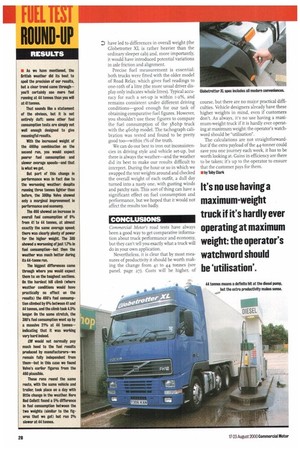FUEL TEST ROUND-UP
Page 30

If you've noticed an error in this article please click here to report it so we can fix it.
RESULTS
• As we have mentioned, the British weather did its best to spoil the precision of our results, but a clear trend came through— you'll certainly use more fuel running at 44 tonnes than you will at 41 tonnes.
That sounds like a statement of the obvious, but it is not entirely daft: some other fuel consumption tests are simply not well enough designed to give meaningful results.
With the increased weight of the 460hp combination on the second run, you would expect poorer fuel consumption and slower average speeds—and that Is what we got.
But part of this change in performance was in fact due to the worsening weather: despite running three tonnes lighter than before, the 380hp Volvo showed only a marginal improvement in performance and economy.
The 460 showed an increase in overall fuel consumption of 6% from 41 to 44 tonnes, at almost exactly the same average speed; there was clearly plenty of power for the higher weight. The 380 showed a worsening of just 1.7% in fuel consumption—but then the weather was much better during its 44-tonne run.
The biggest differences came through where you would expect them to: on the toughest sections. On the hardest hill climb (where weather conditions would have practically no effect on the results) the 460's fuel consumption climbed by 6% between 41 and 44 tonnes, and the climb took 4.5% longer. On the same stretch, the 380's fuel consumption went up by a massive 21% at 44 tonnes— indicating that it was working very hard indeed.
CM would not normally pay much heed to the fuel results produced by manufacturers—we remain fully independent from them—but in this case we found Volvo's earlier figures from the 460 plausible.
These runs round the same route, with the same vehicle and trailer, took place on a day with little change in the weather. Here Rod Collett found a 5% difference in fuel consumption between the two weights (similar to the figures that we got) but ran 2% slower at 44 tonnes.




































































































